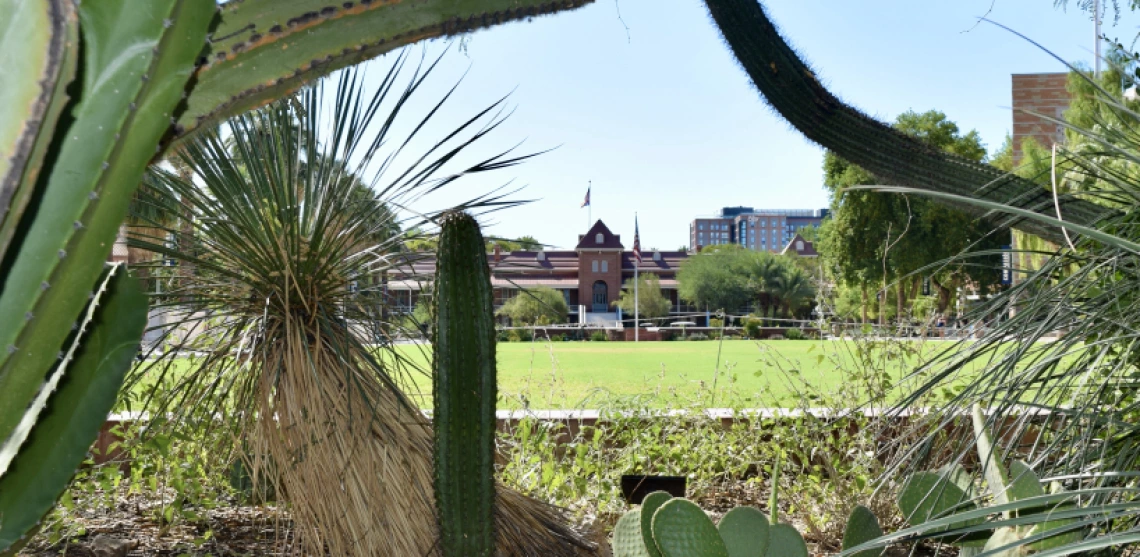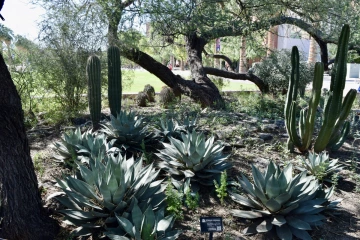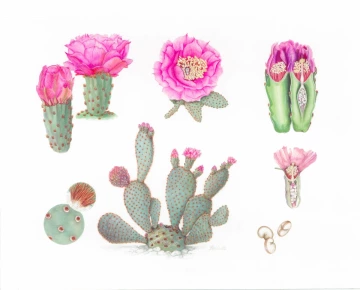The art of scientific illustrations - A hidden desert gem within the city
The Campus Arboretum has established a Florilegium of the Josesph Wood Krutch Garden, in collaboration with Sonoran Desert Florilegium Program artists.

The florilegium is a compilation of illustrations that document the scientific and aesthetic value of the Krutch Garden native plant collection. As the part of the Campus Arboretum’s 20th Anniversary celebrations, a florilegium exhibit aims to inspire visitors to pause, observe, and reflect on the plant kingdom they inhabit.
The University of Arizona Campus Arboretum celebrates its 20th anniversary this year, yet the Arboretum is much older than that. The university has a rich history of researching and cultivating plants, which are represented in the diverse array of exotic and native species we see on campus today.
“Many people do not know where the Arboretum is, yet they’re surrounded by it with every tree they walk by on campus,” said Tanya Quist, director of Uarizona Campus Arboretum and an associate professor in the College of Agriculture, Life and Environmental Sciences’ School of Plant Sciences.

Perhaps one of the most overlooked yet extraordinary gardens within the Arboretum collection is the Historic Joseph Wood Krutch Garden. This garden, filled with Sonoran native species, once covered half of what is now the UA mall. Though the campus landscape has continuously evolved throughout the years and the Krutch Garden has endured multiple relocations, the garden and its resilient plants have been able to withstand the test of time.
According to Quist, the Krutch Garden is the most important garden because it showcases native plants in the middle of an urban landscape. “It’s a reminder of the environment that existed before us,” Quist said. “The more we pause to appreciate the beauty and diversity of plants we pass every day, the more likely we are to consider how our cities and behaviors impact the natural ecosystem.”
One of the main goals of the Campus Arboretum today is to advocate for responsible landscape practices in the desert and to support education in sustainability. Often people tune out things in their environment that are common, a phenomenon Quist calls “plant blindness.”
“The plants that surround us enrich our lives in ways we may not realize and when we open our eyes to the organisms we share this space with, we can nurture a greater respect for the land,” Quist said.
Honoring the campus’ oldest collection

To commemorate the important native species in the Joseph Wood Krutch Garden, the Arboretum commissioned a florilegium – pronouced “flawr-uh-lee-jee-em” – which is a collection of scientific illustrations used as a visually rich historic record.
When it comes to appreciating the beauty of plants, not everyone likes a biology lesson. A florilegium presents the science and history this garden embodies in a way that doesn’t need words– art. It’s a holistic way of communicating science that promotes appreciation for native plants by seeing them in an inspiring and beautiful light.
Diane Inman, one of the artists on the project, shared that working on these botanical illustrations was a great experience for her that challenged her in new ways as an artist. She lives in Northern New Mexico where these plants don’t naturally grow.
“For me, the creative process for botanical art usually has me drawing and painting with the plant next to me. But for the first time, I made my paintings just by looking at photos,” Inman said. As extensive observation is essential to creating accurate scientific illustrations, Diane worked with arboretum student Taylor Roath who took photos of the plants to inform Diane’s work. Taylor also assisted florilgeium artist Pauline Savage, by vigilantly monitoring the garden all Spring as blooms emerged. He then collected, dissected, and photographed these plant features allowing Pauline to accelerate completion of her commissioned work.
The plants that grow here are special and just as the garden itself is biodiverse, so are the artist’s that incorporated their unique style in each illustration.
“We would like to extend our utmost gratitude to the illustrators for pouring such dedication and artistry into honoring the resilience, usefulness, and aesthetic value of these native species,” Quist said. “These plants have learned to survive and adapt in this climate longer than we’ve been inhabiting it and the garden helps us connect back to the roots of this place.”
Illustrating the botanical details of these plants combines art and science as a way to combat plant blindness and gain a greater appreciation for our surroundings, Quist explained.
The florilegium is a way of visually preserving history, in both the University’s past and the iconic and historic specimens of the desert. In acknowledging the evolution of the University’s landscaping practices, the Arboretum can use the campus’ history to educate and propel the next generation of conscientious stewardship of the land.
